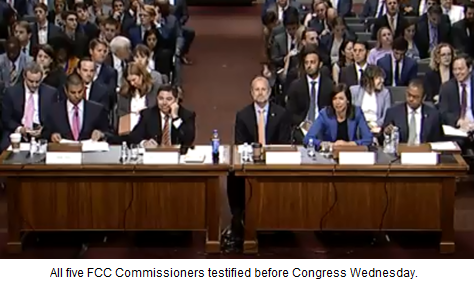The state of the FCC’s broadband maps took center stage as the Senate Commerce Committee members grilled FCC Commissioners in an oversight hearing Wednesday.
Committee Chair Roger Wicker (R-MS) said, “It’s clear to me the FCC should not move forward” on funding more broadband projects “until it gets the maps right.” Wicker said he intends to introduce a bill aimed at getting more granular data about where wired and wireless broadband is available.
Big news was shared by FCC Chairman Ajit Pai, who announced he intends to circulate a Report and Order among his colleagues in time for a vote at the agency’s August meeting, “that would result in more granular and more accurate broadband maps.”
Pai said that means, “requiring broadband providers to report where they actually offer service, below the census block level” at which current data stands. The item would also look to incorporate public feedback into the Commission’s mapping efforts, Pai added. He did not go into specifics, which is normal for an item yet to be voted on.
The announcement seemed to surprise the other commissioners. Indeed, Sen. Brian Schatz (D-HI) reminded Pai that during his latest confirmation hearing, Schatz was concerned about partisanship within the agency. Schatz asked Pai if the Democratic Commissioners knew he was going to make his announcement. Pai said, “No one did.”
Schatz replied: “You just sprung this announcement on your fellow commissioners. They have to be in the loop. We’re all working [to improve] broadband mapping,” he said. He said the fact that an outside interest, Free Press, notified the FCC of flawed data contained in the maps, “demonstrates the weak foundation on which you’re doing your mapping.”
Moving to other topics, Commissioner Michael O’Rielly stressed the need for the agency to free-up more mid-band spectrum for Next Gen wireless use, including “re-doubling our efforts” to reallocate those bands. He specifically cited C-band, which satellite providers use to distribute television and cable programming. “I am hoping the satellite incumbents are willing to part with more than 300 MHz,” O’Rielly said.
Pai said he Commission is working through, “some of the more complicated issues” concerning this band. He referenced the “very complex auction design” proposed recently by the C-Band Alliance and said the agency is moving forward, “as quickly as we can.”
Commissioner Brendan Carr discussed the 5G deployment progress the FCC has made since his first appearance before the committee in 2017. He noted the steps taken by the agency to ease “backpack-sized” small cell deployment by excluding small cells from federal reviews meant for tall towers are bearing fruit. “The number of small cells put up in this country increased from around 13,000 in 2017, to more than 60,000 in 2018,” said Carr.
Carr noted the demand has meant more business for infrastructure manufacturers, citing a plant in Texas that makes poles for 5G which has doubled its output. The telecom industry, “can now fill 20,000 job openings for tower technicians,” Carr said. He discussed his jobs initiative, modeled on a program developed by Aiken Technical College in Graniteville, South Carolina. “In 12 weeks, the program can take someone with virtually no training, teach them the mix of classroom and physical skills necessary to build and install new cell sites, and enable them to land a good-paying job in the tower industry.”
By Leslie Stimson, Inside Towers Washington Bureau Chief
June 13, 2019





Reader Interactions